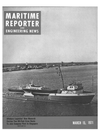
Page 12: of Maritime Reporter Magazine (March 15, 1971)
Read this page in Pdf, Flash or Html5 edition of March 15, 1971 Maritime Reporter Magazine
Rapidly Taking Shape-
The Doctor Lykes
The Quincy Yard Of General Dynamics Passes The 50 Percent Completion Mark For Steel Erection
On The First Of Three SEABEES For Lykes Bros.
Artist's rendering of a SEABEE ship unloading barges. The 2,000-ton elevator at the stern is about to discharge two more barges. The new ships will enter service in 1972. In mid-January, six months after her keel laying, the Doctor Lykes passed the half-way mark in steel erection. Her sisterships, the Tillie
Lykes and Almeria Lykes, were in the steel-cutting and fabrication phases at this point.
These extraordinary ships posed unique design, construction and quality control challenges for their builder, the Quincy Shipbuilding
Division of General Dynamics,
Quincy, Mass.
The SEABEES, as these ships are known, were conceived by Frank
A. Nemec, president of Lykes
Bros. Steamship Company, and de- signed by the New York naval ar- chitectural firm of J.J. Henry Co.,
Inc. The first three are now being constructed for approximately $1CXD million, with the aid of a maritime subsidy. Under the terms of the contract, General Dynamics will collect a bonus of $3,500 for each day the ships are delivered ahead of schedule, and will pay the same penalty for each late day.
Lloyd Bergeson, general man- ager of the Quincy shipyard, in- tends to collect on the bonus. Since taking the helm in October, 1969,
Mr. Bergeson has delivered five
Navy ships on or ahead of sched- ule, and is building the three SEA-
BEES at a record-setting pace.
Mr. Nemec began developing the
SEABEE concept in 1964 follow- ing a trip to Russia where he ob- served Soviet maritime progress.
He was dismayed by the advances he saw and annoyed by the lack of such progressive thinking in the
United States. Motivated by this
Russian trip, Mr. Nemec deter- mined to force a major break- through in the state of the mari- time art. "We wanted a ship that would do what no other merchant ship had done before," he recalled later.
He wanted a ship so flexible she could serve undeveloped coastlines and waterways as well as estab- lished ports, so economical she could out-perform other ships, so versatile she could carry all manner of cargoes in all transport modes singularly or in combinations.
The ship that evolved and now taking shape at Quincy, promises a limitless spectrum of applications, from barge carrier to tanker, from containership to roll-on/roll-off transport or any combination there- of, in either commercial or military service.
Because of her design and mul- tiple missions, the SEABEE has impressive statistics. She will measure 875 feet overall and dis- place 51,000 tons fully loaded. Her 106-foot beam will allow passage through the Panama Canal, and her powerplant of 36,000 shp will make her one of the most powerful sin- gle-screw merchant ships on the seas. Her long length and fine lines will enable her to make 22.1- knot trial speed at a 28-foot draft.
One SEABEE can carry 23,500 tons of cargo in 38 barges on three decks, or 1,800 standard 20-foot containers, equivalent to 2.3 million cubic feet of cargo. The ship also can transport a combination of both barges and containers.
As a military carrier, she is ca- pable of a 15,000-mile voyage and can carry as many vehicles as could clog 5.7 miles of a single- lane highway. In addition, tankage is available for up to 15,000 tons of fuel.
The SEABEE design is flexible primarily because of her elevator and transport system. This is a self-contained unit so the ship does not have the cargo limitations of traditional crane lifts.
This system is the product of an engineering effort participated in by Lykes, J.J. Henry Co., Gen- eral Dynamics, the Rucker Com- pany, Western Gear Corporation,
General Electric and others. The original engineering was started nearly three years prior to the award of the ship-construction con- tract.
The most dramatic aspect of the emerging dream, Mr. Nemec feels, is that the revolutionary SEA-
BEES offer the industry and com- merce of the United States "a com- pletely unfettered and unlimited choice of the kind of ships needed to carry its cargo to and from for- eign destinations."
The first intermodal/barge carrier as it nears 50 percent completion of its steel structure in only six months after keel laying at the Quincy yard.
This stern view shows the cantilever sections extending beyond the stern. In the foreground are the first two girders for the elevator platform.
Landing a 95-ton upper deck section on the Doctor Lykes on January 20 brought the steel erection to over 50 percent completion for the first ship. 14 Maritime Reporter/Engineering News

 11
11

 13
13
